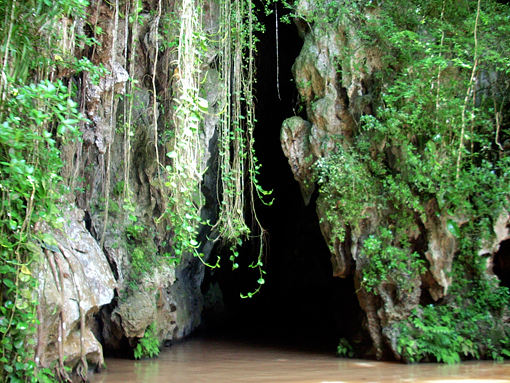Cuba’s Ecological Tourism?
Photo Feature by Isbel Diaz Torres

HAVANA TIMES, Nov. 2 — On a recent trip to the tourist town of Viñales, I learned how the locals understand ecological tourism there.
Viñales and its surrounding valley is one of the most beautiful places in Pinar del Rio province, which is why it’s chosen as a tourist destination by nature lovers. It was to be expected then that the tourism workers there would promote the special care of plants and animals.
Nevertheless, after entering by boat into what’s known as Indian Cave, there appeared before my eyes a depressing spectacle. An otherwise awe-inspiring water buffalo, brought here from Vietnam, posed sadly for the spectators. The animal was outfitted with a harness and saddle to invite people to mount the gigantic-horned beast, which almost always received its riders with a bad attitude.
Then appeared countless tables with the most useless objects on display. All showed the very visible word “CUBA” as a stamp of quality. Surprisingly, the immense majority of the objects were products of the exploitation of animals.

Scorpions were the favorite. Their inert bodies adorned hundreds of key rings and paperweights. I asked the vendor about the origin of the animals, and this young guy explained that they came from a scientific institution in Matanzas that extracts scorpion venom for therapeutic purposes.
It didn’t seem to me that the extraction of venom would necessarily lead to the death of those arachnids. What’s more, many of the specimens on display there were young, which would have made it difficult for them to have been used for obtaining venom.
Neither did the hundreds of tiny crabs and snails on sale there produce any venom useful for humans. Where did those come from? – From our rivers and coasts. No population studies have been conducted to learn how to farm these without endangering those species, yet this indiscriminate exploitation is tolerated by the local officials.
The same can be said of the objects made based on beautiful wood, bull horns, tortoiseshells, and other parts of once living beings. The tortoiseshell objects, at least in the handicraft markets in Havana, are not displayed in plain view. You have to ask the vendors for these; then, as if they were so many grams of cocaine, they’ll discreetly walk you to some safe place where they can show you the goods.

The end of the journey of the trinket displays is reserved for kitsch “revolutionary art bazaars,” where the images of political figures like Fidel, Che and Camilo adorn T-shirts, berets and key rings. Books by these leaders, along with the “Constitution of the Republic of Cuba,” are sold to tourists.
I don’t think that it’s necessary to point out that all the sales of these wares are all carried out in Cuba’s hard currency, the CUC. This being the case, a “Guevarian” beret represents forty percent of my monthly wage.
Nonetheless, I don’t expect that those images diminish the joy. In the end, like the message on one picturesque T-shirt conveyed so well: “In Cuba evens the chickens dance.”
Click on the tumbnails below to view all the photos in this gallery






























PS. using cattle horns to make trinkets is not a big deal. Ranchers cut the horns off of cattle anyway. The mislabled “snail” shells are actually various sea shells which are easily found on the beach discarded by their animal owners when they grow out of them or die. I bought many necklaces in Cuba made of bone… I am pretty certain the animals were already dead!
I’ve been to that cave but didn’t see a water the beast of burden you mention nor the animal derived trinkets. That must be new. It would have bothered me as much as it did the author. But, I also don’t see any trinkets with Fidel’s image as the author suggests. I have never seen Fidel’s face on any trinkets or t-shirts etc. in Cuba. It just isn’t done. The one image here is on a book cover. Regarding the price of the Che beret… well, Cubans aren’t really the targets of the sellers are they? The sellers are basically doing what all people do who work in tourist areas…. get money out of the hands of the “wealhy” into the hands of the masses. Tourism is one of the few mechanisms for direct “trickle down economics”. While the price seems high to the Cuban author… tourist trinkets in Cuba are cheaper than most tourist gear anywhere else in the world…